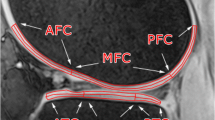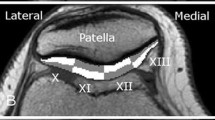Summary
To determine the characteristics of magnetic resonance (MR) signals of normal growing cartilage and identify the difference in transverse relaxation times between physeal and epiphyseal cartilagein vivo, 24 distal femora of 12 two-week-old pigiets were imaged on a 1. 5 Tesla GE MR scanner. Comparison was made between signal intensity on MR images and the structure shown in corresponding histologic sections. T2 values were measured in eight piglets by means of multiecho spin-echo sequences. Our results showed that MR imaging delineated five regions between the secondary ossification center and the metaphysis, which histologically correspond to the zone of provisional calcification of the secondary ossification center, physics of the secondary ossification center, epiphyseal cartilage, physis and zone of provisional calcification. The T2 value in the physeal cartilage was much larger than that in the epiphyseal cartilage (P<0.05). It is concluded that MRI findings could differentiate the different regions of growing cartilage. T2 is longer in physeal than in epiphyseal cartilage, perhaps reflecting differences in water binding by proteoglycans.
Similar content being viewed by others
References
Shapiro F. Epiphyseal disorders. N Engl J Med, 1987, 317(8):1702
Jaramillo D, Connolly S, Mulkern R, Shapiro F. Developing Epiphysis: MR Imaging Charateristics and Histologic Correlation in the Newborn Lamb. Rodiology, 1998, 207(2):637
Mulkern R V, Wong S T S, Jakab Pet al. CPMG imaging sequences for high field in vivo trnasverse relaxation studies. Magn Reson Med, 1990, 67:16
Chung T, Jaramillo D. Normal maturing distal tibia and fibula: changes with age at MR imaging. Radiology, 1995, 194(1):227
Jaramillo D, Laor T, Mulkern R V. Comparison between fast spin-echo and conventional spin-echo imaging of normal and abnormal musculoskeletal structures in children and young adults. Invest Radiol, 1994, 29(1): 803
Babyn P, Kim H, Lemaire Cet al. High-resolution magnetic resonance imaging of normal porcine cartilaginous epiphyseal maturation. JMRI, 1996, 1(1):172
Pradip PK, Jasani MK, Sebok D,et al. Variation in MR signal intensity across normal human knee cartilage. JMRI, 1993, 3(3):569
Dardzinski B, Mosher T, Li Set al. Spatial variation of T2 in human articular cartilage. Radiology, 2002, 205 (2):546
Dardzinski B, Laor T, Schmithorst Vet al. Mapping T2 relaxation time in the pediatric knee: Feasibility with a clinical 1.5-tTMR imaging system. Radiology, 2002, 225(1):233
Author information
Authors and Affiliations
Additional information
LI Xiaoming, female, born in 1968, Associate Professor
This project is supported by a grant from the National Natural Science Foundation of China (No. 30370430).
Rights and permissions
About this article
Cite this article
Xiaoming, L., Renfa, W., Yonggang, L. et al. MRI characteristics and transverse relaxation time measurements in normal growing cartilage. Current Medical Science 24, 411–413 (2004). https://doi.org/10.1007/BF02861881
Received:
Published:
Issue Date:
DOI: https://doi.org/10.1007/BF02861881




